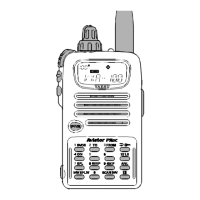VXA-100 AVIATOR PILOT OPERATING MANUAL
6
BEFORE YOU BEGIN
Precautions
r This apparatus is capable of two-way communi-
cation on channels used for critical aviation safety
communications. Therefore, it is important that
this radio be kept away from children or other
unauthorized users at all times.
r When making DC connections via the E-DC-5B
DC cable, be absolutely certain to observe the
proper voltage level and polarity guidelines. Do
not connect this radio directly to any 24 ~ 28
Volt DC source, nor to AC power of any kind.
Connecting the VXA-100 directly to a source
which exceeds 15.0 Volts DC will result in dam-
age to the unit.
r Do not dispose of the Ni-Cd Battery Pack in a
fire. Do not carry a Ni-Cd Battery Pack in your
pocket, where keys or coins could short the ter-
minals. This could create a serious fire/burn dan-
ger, and possibly cause damage to the Ni-Cd
pack.
r Although the VXA-100 is designed to be water
resistant, the enclosure is not “waterproof.” Do
not allow the radio to become submersed in wa-
ter, and do not expose it and/or its Ni-Cd Battery
Pack to water spray under pressure.
Battery Installation and Removal
Refer to the illustration below showing the rear panel
of the VXA-100 and its battery pack.
¦ Lay the battery pack loosely onto the rear panel
of the transceiver, and carefully mate the four
small alignment tabs on the battery with their cor-
responding insertion slots on the transceiver case.
Proper alignment occurs with the battery pack
offset about ½” from the top of the case.

